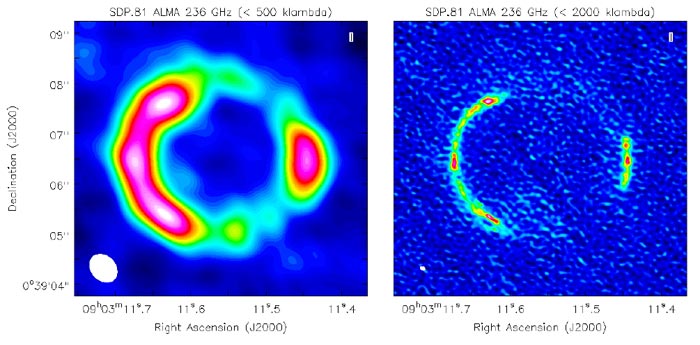Dusty substructure in a galaxy far far away

Fig. 1 The ALMA image of the continuum emission at 236 GHz of the lensed galaxy SDP.81 at two angular resolutions. The lensed system consists of four images with an extended, low-surface brightness Einstein ring.
Galaxies are constantly forming new stars within dense clouds of interstellar material. The star formation rate in today's galaxies is, however, much lower than it used to be. When the universe was about a quarter its current age, star formation was at its peak, and so astronomers are keen to learn about this period.
Looking back in time is possible because of the finite speed of light, but only by looking out to great distances, which in turn means that young galaxies appear very small and very faint. In addition, most of their new-born stars cannot be seen directly, because their radiation is absorbed by dust in the surrounding gas cloud and is re-emitted at far-infrared wavelengths.
As a result, star-forming regions in distant galaxies are one of the prime targets for the Atacama Large Millimetre/submillimetre Array. ALMA will consist of 66 high precision antennas, located on the Chajnantor plateau at 5000 meters altitude in northern Chile.
The data from the individual antennas can be combined interferometrically, and the 15 kilometre span of the telescope provides resolution of better than a tenth of an arc-second. On its own, however, even this capability is not sufficient to make detailed pictures of young galaxies at the peak of their star formation.
“At a recent conference, ALMA scientists presented data they had used to verify the scientific capabilities of their array, among them an image of a strongly gravitationally lensed system, which immediately raised our interest”, remembers Simona Vegetti, postdoctoral scientist at MPA.
“Because of the lensing, the background galaxy is strongly magnified, by 17 times actually, which is why we can see it at all. Together with ALMA's unique angular resolution, this gave us the chance to try and see details in the distribution of dust in such a far-away galaxy for the first time.”
Strong gravitational lensing happens when a background galaxy is closely aligned with a foreground mass concentration such as a cluster of galaxies, which bends light-rays from the source on their way to the observer. The foreground lens is, however, an imperfect optical system, leading to very large distortions (see Fig. 1).
Nevertheless, from the properties of the lensed images, the mass distribution of the lensing system can be determined and a “true” (i.e. undistorted) image of the distant galaxy can be reconstructed. “Previous attempts to do this had assumed the background galaxies to be smooth and regular”, explains Matus Rybak, who carried out the computer modelling at MPA. “This seems likely to be a very poor approximation to the structure of a strongly star-forming galaxy, and the raw ALMA images gave clear hints that this background source is complex. The new, more general approach we have developed is much better suited to irregular systems.”
This intuition is borne out by the reconstructed image of the galaxy SDP.81 which shows star formation to be concentrated in three distinct regions (see Fig. 2). “This is the first time, that we can see structure in the dust emission of a z=3 galaxy on scales smaller than 150 light-years”, points out Simona Vegetti. At this cosmic time, typical galaxies were forming stars at their peak rate, and indeed SDP.81 is forming about 300 solar masses of stars every year. (In our Milky Way, the star formation rate is about 3 solar masses per year.)
The complex structure of the galaxy may indicate that it is a rotating disk with a central bulge that is seen (and lensed) edge-on; alternatively it may be a system which is undergoing a merger in which the separate components are still visible. To distinguish between these possibilities, data on the motions of gas within the galaxy are needed, so the next step for the MPA team together with their colleagues Paola Andreani at ESO and John McKean at the University of Groningen and the Netherlands Institute for Radio Astronomy (ASTRON) will be to analyse the molecular line observations of this system which ALMA has also obtained.
Links:
Original publication
ALMA imaging of SDP.81 I. A pixelated reconstruction of the far-infrared continuum emission, M. Rybak, J. P. McKean, S. Vegetti, P. Andreani and S. D. M. White, linkPfeilExtern.gifsubmitted to MNRAS
Contact:
Simona Vegetti
Max-Planck-Institut für Astrophysik
Phone: 089 30000-2285
Email: svegettimpa-garching.mpg.de
Hannelore Hämmerle
Press Officer
Max-Planck-Institut für Astrophysik
Tel. +49 89 30000-3980
E-mail: prmpa-garching.mpg.de
Media Contact
All latest news from the category: Physics and Astronomy
This area deals with the fundamental laws and building blocks of nature and how they interact, the properties and the behavior of matter, and research into space and time and their structures.
innovations-report provides in-depth reports and articles on subjects such as astrophysics, laser technologies, nuclear, quantum, particle and solid-state physics, nanotechnologies, planetary research and findings (Mars, Venus) and developments related to the Hubble Telescope.
Newest articles

Properties of new materials for microchips
… can now be measured well. Reseachers of Delft University of Technology demonstrated measuring performance properties of ultrathin silicon membranes. Making ever smaller and more powerful chips requires new ultrathin…

Floating solar’s potential
… to support sustainable development by addressing climate, water, and energy goals holistically. A new study published this week in Nature Energy raises the potential for floating solar photovoltaics (FPV)…

Skyrmions move at record speeds
… a step towards the computing of the future. An international research team led by scientists from the CNRS1 has discovered that the magnetic nanobubbles2 known as skyrmions can be…





















